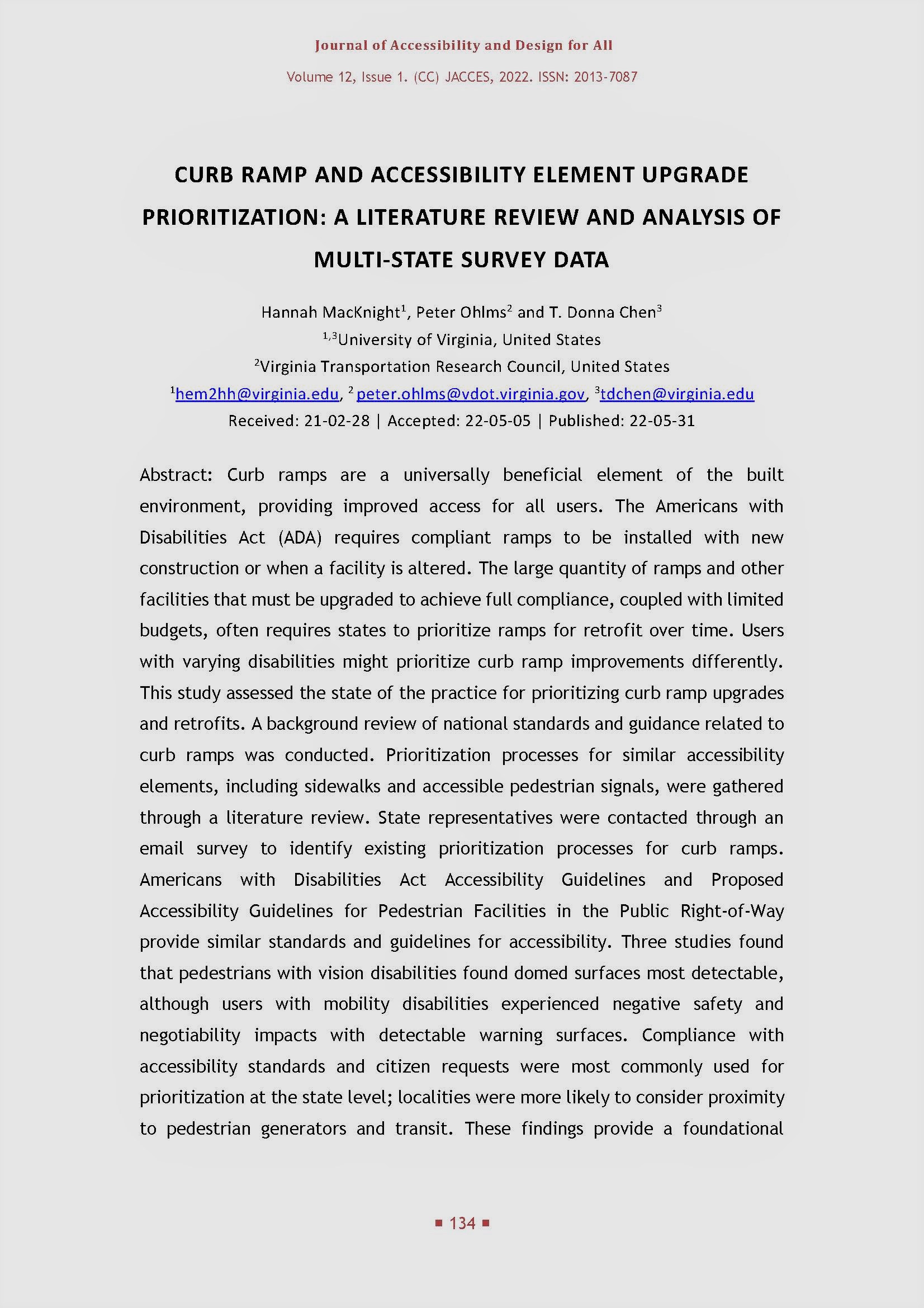Curb ramp and accessibility element upgrade prioritization
DOI:
https://doi.org/10.17411/jacces.v12i1.334Abstract
Curb ramps are a universally beneficial element of the built environment, providing improved access for all users. The Americans with Disabilities Act (ADA) requires compliant ramps to be installed with new construction or when a facility is altered. The large quantity of ramps and other facilities that must be upgraded to achieve full compliance, coupled with limited budgets, often requires states to prioritize ramps for retrofit over time. Users with varying disabilities might prioritize curb ramp improvements differently. This study assessed the state of the practice for prioritizing curb ramp upgrades and retrofits. A background review of national standards and guidance related to curb ramps was conducted. Prioritization processes for similar accessibility elements, including sidewalks and accessible pedestrian signals, were gathered through a literature review. State representatives were contacted through an email survey to identify existing prioritization processes for curb ramps. Americans with Disabilities Act Accessibility Guidelines and Proposed Accessibility Guidelines for Pedestrian Facilities in the Public Right-of-Way provide similar standards and guidelines for accessibility. Three studies found that pedestrians with vision disabilities found domed surfaces most detectable, although users with mobility disabilities experienced negative safety and negotiability impacts with detectable warning surfaces. Compliance with accessibility standards and citizen requests were most commonly used for prioritization at the state level; localities were more likely to consider proximity to pedestrian generators and transit. These findings provide a foundational resource for agencies developing or revising prioritization processes for curb ramp retrofits.References
Anderson, R. N. (2018). A Methodology to Prioritize Absent Sidewalk Infrastructure for San Antonio, Texas. The University of Texas at Austin, Austin, Texas. https://repositories.lib.utexas.edu/handle/2152/65758
Arnold, E. D., & Dougald, L. E. (2003). Guidelines for the Retrofit Installation of Accessible Pedestrian Signals by the Virginia Department of Transportation: Phase I Report (No. VTRC 03-TAR3) (p. 53). Charlottesville, Virginia: Virginia Transportation Research Council. https://rosap.ntl.bts.gov/view/dot/19669
Bentzen, B. L., Nolin, T. L., Easton, R. D., Desmarais, L., & Mitchell, P. A. (1994). Detectable Warnings: Detectability by Individuals with Visual Impairments, and Safety and Negotiability on Slopes for Persons with Physical Impairments (No. DOT-VNTSC-FTA-94-4) (p. 124). Cambridge, Mass: Volpe National Transportation Systems Center. https://rosap.ntl.bts.gov/view/dot/10526
Blackwell, A. G. (2017). The Curb-Cut Effect. Stanford Social Innovation Review, 15(1), 28–33. https://doi.org/10.48558/YVMS-CC96
Boyer, D., Walls, D., Dyess, C., Greenwald, J., & Guensler, R. (2018). Sidewalk Prioritization Index: Objective and Transparent Sidewalk Asset Management. Presented at the TRB 16th Tools of The Trade Conference, Kansas City, Missouri. https://onlinepubs.trb.org/onlinepubs/Conferences/2018/Tools/DBoyer.pdf
City of Charlotte Department of Transportation. (2017). Charlotte WALKS Pedestrian Plan (p. 178). Charlotte, North Carolina. Retrieved May 24, 2020, from https://charlottenc.gov/Transportation/Programs/Documents/
Charlotte%20WALKS%20Adopted%20Plan%20-%20February%202017.pdf
City of Falls Church. (2012). Self-Evaluation Update and Americans with Disabilities Act (ADA) Transition Plan for Public Rights-of-Way (p. 92). https://www.fallschurchva.gov/DocumentCenter/View/1648/ADA-Transition-Plan?bidId=
City of Frisco. (2014). City of Frisco ADA Self-Evaluation and Transition Plan. Retrieved June 15, 2020, from https://www.friscotexas.gov/
DocumentCenter/View/13199/Frisco-ADA-Transition-Plan?bidId=
City of San Antonio. (n.d.). Regional Centers. SA-Tomorrow. Retrieved May 20, 2020, from https://sacompplan.com/regional-centers/
Frackelton, A. (2013). Pedestrian Transportation Project Prioritization Incorporating App-Collected Sidewalk Data. Georgia Institute of Technology. https://smartech.gatech.edu/handle/1853/50334
Harkey, D. L., Carter, D. L., Barlow, J. M., & Bentzen, B. L. (2007). NCHRP Web-Only Document 117A: Accessible Pedestrian Signals: A Guide to Best Practice. Retrieved May 20, 2020, from http://onlinepubs.trb.org/
onlinepubs/nchrp/nchrp_w117a.pdf
Lee, H. (2011). The Effects of Truncated Dome Detectable Warnings on Travelers Negotiating Curb Ramps in Wheelchairs. Journal of Visual Impairment & Blindness, 105(5), 276–286. https://doi.org/10.1177%2F0145482X1110500505
MIG, Inc. (2017). City of Redmond ADA Transition Plan (p. 111). https://www.redmondoregon.gov/home/showpublisheddocument/12092/636287134966970000
O’Leary, A. A., Lockwood, P. B., Taylor, R. V., & Lavely, J. L. (1995). An Evaluation of Detectable Warning Surfaces for Sidewalk Curb Ramps (No. VTRC 95-R31) (p. 63). Charlottesville, Virginia: Virginia Transportation Research Council. https://rosap.ntl.bts.gov/view/dot/19395
Rosenberg, D. E., Huang, D. L., Simonovich, S. D., & Belza, B. (2013). Outdoor Built Environment Barriers and Facilitators to Activity among Midlife and Older Adults with Mobility Disabilities. The Gerontologist, 53(2), 268–279. https://academic.oup.com/gerontologist/article/53/2/268/563499
United States Access Board. (2004). Americans with Disabilities Act and Architectural Barriers Act Accessibility Guidelines. Retrieved May 25, 2020, from https://www.access-board.gov/attachments/article/412/ada-aba.pdf
United States Access Board. (2011). Proposed Accessibility Guidelines for Pedestrian Facilities in the Public Right-of-Way. Retrieved May 25, 2020, from https://www.access-board.gov/attachments/article/743/nprm.pdf
U.S. Department of Justice. (2010a). 2010 ADA Standards for Accessible Design. Retrieved May 25, 2020, from https://www.ada.gov/regs2010/
ADAStandards/2010ADAStandards.pdf
U.S. Department of Justice. (2010b). Americans with Disabilities Act: Title II Regulations. Retrieved May 25, 2020, from https://www.ada.gov/regs
/titleII_2010/titleII_2010_regulations.pdf
VDOT. (2019). VDOT ADA Transition Plan. Retrieved June 29, 2020, from http://www.virginiadot.org/business/resources/Civil_Rights/Section_ADA-504_Transition_Plan_2019.pdf

Downloads
Published
How to Cite
Issue
Section
License
Copyright (c) 2022 Hannah MacKnight, Peter Ohlms, T. Donna Chen

This work is licensed under a Creative Commons Attribution-NonCommercial 4.0 International License.
- Authors retain copyright and grant the journal right of first publication with the work simultaneously licensed under a Creative Commons Attribution License that allows others to share or adapt the work with an acknowledgment of the work's authorship and initial publication in this journal. Use of the work for commercial purposes are not allowed.
- Authors are able to publish the journal's published version of the work in other media (e.g., post it to an institutional repository or publish it in a book), as far as they inform the Journal of Accessibility and Design for All of that fact. When publishing their work in other sources, authors must mention the name of the Journal of Accessibility and Design for All, its ISSN, the number and issue in which the article was published and a link to the main page of the Journal of Accessibility and Design for All. Optionally, they can also include a link to the article published in the Journal of Accessibility and Design for All.
- Authors are permitted and encouraged to post their work online (e.g., in institutional repositories or on their website), as it can lead to productive exchanges, as well as earlier and greater citation of published work.



